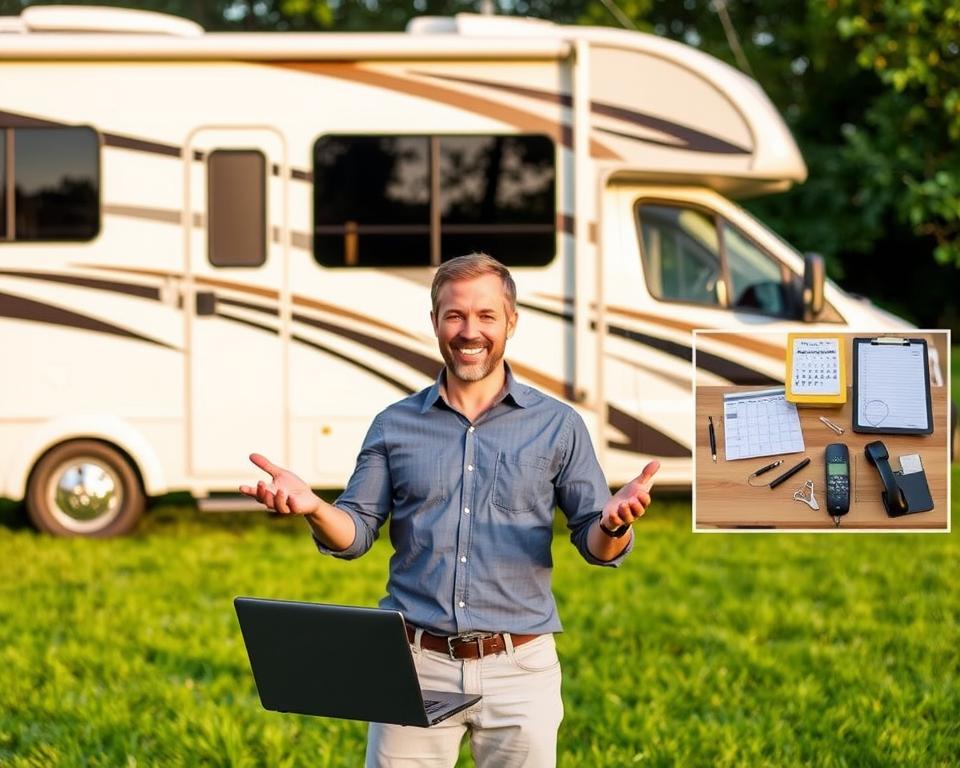Rural Prather RV Tank Pumping: Services for Remote Areas
RV Waste Tank Pumping: Vital Maintenance Advice
Imagine what happens when you ignore your RV’s sewer setup. A lot of motorhome owners dread tank emptying. However, recognizing the need for regular servicing is crucial. Such measures keep your trips worry-free and prevent costly fixes. Mastering correct waste handling is fundamental to your system’s longevity. Here are key pointers on RV septic service near me with upkeep advice to ensure your system operates flawlessly.
The Basics of Your RV Sewage System
Your RV includes tanks designed for different wastes. The system comprises a black water tank (toilet), a gray water tank (sinks/showers), and a fresh water tank. Grasping how each part works is key to proper black tank servicing and overall system care.
A series of drain lines and vent pipes balance waste flow and airflow. A good grasp prevents clogs and nasty odors. It’s the foundation of a smooth camping experience.
Regular checks and care keep your tanks in top shape. Frequently checking tank levels and emptying on time preserves comfort. Proper upkeep extends tank life and enhances every journey.
The Value of Consistent Septic Maintenance
Frequent tank pumping keeps your system working and clean. Leftover solids lead to smells and clogs, spoiling your trip. A full tank can produce embarrassing backups. Such mishaps kill the fun on the road.
Skipping pump-outs leads to pricey repairs. System failures cause leaks and wear out parts prematurely. Timely emptying keeps your plumbing running smoothly. It prevents unwelcome surprises and roadside emergencies.
Proactive servicing stops clogs. Dedicating effort to pumping reflects good RV stewardship. It greatly improves your travel experience. By sticking to a dump schedule, you’ll relish the outdoors worry-free.
Recommended Pump-Out Intervals
Timing your tank dumps depends on several variables. Generally, dump every 3–5 days when in use. However, it shifts based on tank volume and number of users. Pinpointing the correct dump time is key for effective wastewater management.
Empty once the black tank reaches roughly 66% full. This prevents solids from clogging and keeps flow steady. Ignoring it can cause backups and unpleasant odors.
Many elements can affect how often you pump:
- Number of people on board
- Length of stay
- Type of waste generated
- Tank capacity
Planning is key to avoiding emergencies. Remember portable toilet service schedules. Tracking your usage helps forecast dump needs.
| Usage Scenario | Pumping Frequency |
|---|---|
| Short Trip, Two Campers | Every 3–4 days |
| Extended Trip (4–6 people) | Every 2–3 days |
| Seasonal Use, Two to Four Campers | Weekly or Bi-Weekly |
Keep a close eye on tank levels and your habits. Staying attentive guarantees a pleasant trip.

Proper Tank Dumping Techniques
Correct dumping preserves system health and prevents issues. Begin with the black tank to avoid cross-contamination. This prevents dirty water from fouling the clean.
A sturdy sewer hose reduces spill chances and aids flow. Secure all fittings firmly to avoid leaks. Once both tanks are clear, rinse the black tank thoroughly. This removes residue and preps the tank for next time.
Know where dump stations are located. Being prepared saves time on the road.
In short, follow these key steps for efficient dumping:
- Empty the black water tank first.
- Use a top-quality sewer hose.
- Flush the black tank thoroughly after emptying.
- Plan your dump station locations.
Following these guidelines simplifies black tank maintenance.
Proper Use and Maintenance of Your RV Tanks
Grasping correct handling of black and gray tanks ensures system health. Keep some water in the black tank for better breakdown.
Don’t flush wipes, feminine products, or paper towels. Use only RV-compatible paper. Inspect tanks often to catch problems early.
Adding treatments now and then improves septic service. They introduce microbes that digest solids effectively. Such measures keep your tanks operating at their best.
- Check for leaks and damage often.
- Apply RV-specific chemical treatments.
- Keep vents clear to avoid odors.
Adhering to these practices safeguards your system. You’ll enjoy more worry-free trips.
How to Pump Efficiently
Successful pumping requires precision and a clear procedure. It’s essential to use designated dump stations. Understanding volume limits prevents spills on the go.
Check tank indicators regularly to time pump-outs. Routine scheduling preserves your septic system and travel enjoyment. A planned maintenance routine keeps everything running smoothly.
Flush well after every emptying. It ensures each dump is cleaner than the last. By applying these strategies, you’ll maintain your RV’s condition and comfort.
Avoid These Septic System Errors
Upkeep prevents trip interruptions. Insufficient flushing causes solids to accumulate. Proper flushing dissolves waste better.
Flushing inappropriate items blocks pipes. Avoid non-dissolvable products like feminine hygiene items. They cause backups and costly service calls.
Keep the black tank valve closed until ready to dump. Open valves let water out but hold solids, causing residue. Only open when ready to empty for a complete clean.
Awareness of these errors boosts system longevity. Steering clear of these mistakes ensures durable performance.
When to Seek Professional Septic Services
Recognizing the need for expert help extends tank life. Lingering smells can mean serious tank problems. Tanks that empty sluggishly hint at internal blockages.
Waste spillage near dump sites signals trouble. Such situations usually need high-pressure cleaning. Pros blast away blockages to restore smooth flow.
Routine professional inspections catch hidden issues early. Early intervention avoids expensive failures. Hiring qualified technicians saves time and money long term.
Ongoing Septic Care Tips
Smart upkeep ensures lasting system performance. Scheduled dumps preserve longevity and operation. Routine rinses clear residue and stave off expensive breakdowns.
Implementing clean cycles safeguards tank health. Checking seals and joints avoids leaks. Choosing eco-friendly treatments avoids damage.
Keep these habits in mind:
- Stick to a pump-out timetable.
- Rinse often to remove solids.
- Sanitize twice a year.
- Inspect parts frequently for wear and tear.
Investing in prevention brings peace of mind. Routine service lets you focus on the scenery, not your sewer.
Conclusion
Good septic care ensures enjoyable trips. Understanding operation and following guidelines prevents headaches. Routine black tank dumping boosts performance. It enhances every mile.
By regularly checking and properly caring for your septic setup, you’ll ensure worry-free travel. Dependable sewage service backs every adventure. Adopting these habits keeps your RV ready to roll. So you can focus on making memories, not dealing with tanks.

